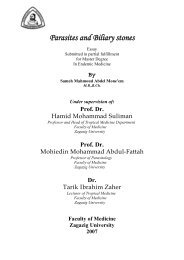E. Coli
E. Coli
E. Coli
You also want an ePaper? Increase the reach of your titles
YUMPU automatically turns print PDFs into web optimized ePapers that Google loves.
Review of Literature<br />
pencillin (68.88%), furazolidone (83.13%) and kanamycin (61.67%)<br />
ampicillin (51.12%), chloramphenical (50.23%), and streptomycin<br />
(44.84%).<br />
Filali et al. (1988) isolated sixty two strains of E. coli (O:78,<br />
O:1&O:2) from 58 broiler farms suffering from respiratory signs and<br />
lesion characteristic to avian colibacillosis .All strains of isolated E.<br />
coli were sensitive to colistin, flumequine and gentamycin .A few<br />
strains were resistant to neomycin, nalidixic acid and trimethoprim.<br />
The frequently strains Resistant to nitrofurans, sulfonamides,<br />
chloramphenicol, spestinomycin and ampicillin was intermediate.<br />
Most strains were resistant to tetracycline.<br />
Adesiyum and Kaminjoli (1992) found that E. coli isolates were<br />
most resistant to streptomycin (81%) and tetracycline (79%) and least<br />
resistant to chloramphenicol (4%) and gentamycin (5%) The<br />
predominant resistance pattern for all isolate was streptomycintetracycline<br />
(28%).<br />
Osman (1992) reported that the sensitivity test for E. coli gave<br />
superior results with lincospectin (85-71%) followed by streptomycin,<br />
nitro furans, erythromycin, gentamycin, flumequine, nalidixic acid,<br />
sulfate with activity percentage of 80.9%, 78.5%, 73.8%, 6606%,<br />
59.5%52. 3%,42.8%, 40.4%, 23.8% and 19.5%, respectively.<br />
Meanwhile no effect could be observed with neomycin.<br />
Dinh and Nguyen (1995) studied the efficiency of antibiotics<br />
(streptomycin, chloramphenical, tetracycline, furazolidone, neomycin,<br />
19
















